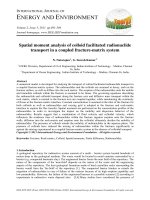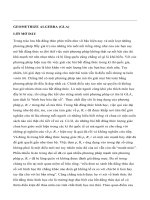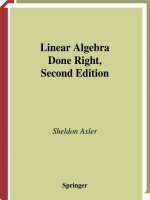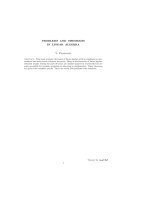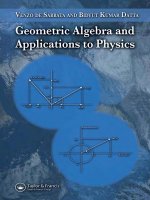matrix algebra
Bạn đang xem bản rút gọn của tài liệu. Xem và tải ngay bản đầy đủ của tài liệu tại đây (821.54 KB, 63 trang )
1
© 2001 by CRC Press LLC
Matrix Algebra
and Solution
of Matrix Equations
1.1 INTRODUCTION
Computers are best suited for repetitive calculations and for organizing data into
specialized forms. In this chapter, we review the
matrix
and
vector
notation and
their manipulations and applications. Vector is a one-dimensional array of numbers
and/or characters arranged as a single column. The number of rows is called the
order
of that vector. Matrix is an extension of vector when a set of numbers and/or
characters are arranged in rectangular form. If it has M rows and N column, this
matrix then is said to be of order M by N. When M = N, then we say this
square
matrix is of order N (or M). It is obvious that vector is a special case of matrix when
there is only one column. Consequently, a vector is referred to as a column matrix
as opposed to the row matrix which has only one row. Braces are conventionally
used to indicate a vector such as {V} and brackets are for a matrix such as [M].
In writing a computer program, DIMENSION or DIM statements are necessary
to declare that a certain variable is a vector or a matrix. Such statements instruct
the computer to assign multiple memory spaces for keeping the values of that vector
or matrix. When we deal with a large number of different entities in a group, it is
better to arrange these entities in vector or matrix form and refer to a particular
entity by specifying where it is located in that group by pointing to the row (and
column) number(s). Such as in the case of having 100 numbers represented by the
variable names A, B, …, or by A(1) through A(100), the former requires 100 different
characters or combinations of characters and the latter certainly has the advantage
of having only one name. The A(1) through A(100) arrangement is to adopt a vector;
these numbers can also be arranged in a matrix of 10 rows and 10 columns, or 20
rows and five columns depending on the characteristics of these numbers. In the
cases of collecting the engineering data from tests of 20 samples during five different
days, then arranging these 100 data into a matrix of 20 rows and five columns will
be better than of 10 rows and 10 columns because each column contains the data
collected during a particular day.
In the ensuing sections, we shall introduce more definitions related to vector
and matrix such as transpose, inverse, and determinant, and discuss their manipula-
tions such as addition, subtraction, and multiplication, leading to the organizing of
systems of linear algebraic equations into matrix equations and to the methods of
finding their solutions, specifically the Gaussian Elimination method. An apparent
application of the matrix equation is the transformation of the coordinate axes by a
© 2001 by CRC Press LLC
rotation about any one of the three axes. It leads to the derivation of the three basic
transformation matrices and will be elaborated in detail.
Since the interactive operations of modern personal computers are emphasized
in this textbook, how a simple three-dimensional brick can be displayed will be
discussed. As an extended application of the display monitor, the transformation of
coordinate axes will be applied to demonstrate how animation can be designed to
simulate the continuous rotation of the three-dimensional brick. In fact, any three-
dimensional object could be selected and its motion animated on a display screen.
Programming languages,
FORTRAN
,
QuickBASIC
,
MATLAB
, and
Mathe-
matica
are to be initiated in this chapter and continuously expanded into higher
levels of sophistication in the later chapters to guide the readers into building a
collection of their own programs while learning the computational methods for
solving engineering problems.
1.2 MANIPULATION OF MATRICES
Two matrices [A] and [B] can be added or subtracted if they are of same order, say
M by N which means both having M rows and N columns. If the sum and difference
matrices are denoted as [S] and [D], respectively, and they are related to [A] and
[B] by the formulas [S] = [A] + [B] and [D] = [A]-[B], and if we denote the elements
in [A], [B], [D], and [S] as a
ij
, b
ij
, d
ij
, and s
ij
for i = 1 to M and j = 1 to N, respectively,
then the elements in [S] and [D] are to be calculated with the equations:
(1)
and
(2)
Equations 1 and 2 indicate that the element in the ith row and jth column of [S]
is the sum of the elements at the same location in [A] and [B], and the one in [D]
is to be calculated by subtracting the one in [B] from that in [A] at the same location.
To obtain all elements in the sum matrix [S] and the difference matrix [D], the index
i runs from 1 to M and the index j runs from 1 to N.
In the case of
vector
addition and subtraction, only one column is involved (N =
1). As an example of addition and subtraction of two vectors, consider the two
vectors in a two-dimensional space as shown in Figure 1, one vector {V
1
} is directed
from the origin of the x-y coordinate axes, point O, to the point 1 on the x-axis
which has coordinates (x
1
,y
1
) = (4,0) and the other vector {V
2
} is directed from the
origin O to the point 2 on the y-axis which has coordinates (x
2
,y
2
) = (0,3). One may
want to find the resultant of {R} = {V
1
} + {V
2
} which is the vector directed from
the origin to the point 3 whose coordinates are (x
3
,y
3
) = (4,3), or, one may want to
find the difference vector {D} = {V
1
} – {V
2
} which is the vector directed from the
origin O to the point 4 whose coordinates are (x
4
,y
4
) = (4,–3). In fact, the vector
{D} can be obtained by adding {V
1
} to the negative image of {V
2
}, namely {V
2–
}
which is a vector directed from the origin O to the point 5 whose coordinates are
(x
5
,y
5
). Mathematically, based on Equations 1 and 2, we can have:
sab
ij ij ij
=+
dab
ij ij ij
=−
© 2001 by CRC Press LLC
and
When Equation 1 is applied to two arbitrary two-dimensional vectors which
unlike {V
1
}, {V
2
}, and {V
2–
} but are not on either one of the coordinate axes, such
as {D} and {E} in Figure 1, we then have the sum vector {F} = {D} + {E} which
has components of 1 and –2 units along the x- and y-directions, respectively. Notice
that O467 forms a parallelogram in Figure 1 and the two vectors {D} and {E} are
the two adjacent sides of the parallelogram at O. To find the sum vector {F} of {D}
and {E} graphically, we simply draw a diagonal line from O to the opposite vertex
of the parallelogram — this is the well-known
Law of Parallelogram
.
It should be evident that to write out a vector which has a large number of rows
will take up a lot of space. If this vector can be rotated to become from one column
to one row, space saving would then be possible. This process is called transposition
as we will be leading to it by first introducing the length of a vector.
For the calculation of the
length
of a two-dimensional or three-dimensional vector,
such as {V
1
} and {V
2
} in Figure 1, it would be a simple matter because they are
oriented along the directions of the coordinate axes. But for the vectors such as {R}
FIGURE 1.
Two vectors in a two-dimensional space.
RVV
{}
=
{}
+
{}
=
+
=
12
4
0
0
3
4
3
DV V
{}
=
{}
−
{}
=
−
=
−
12
4
0
0
3
4
3
© 2001 by CRC Press LLC
and {D} shown in Figure 1, the calculation of their lengths would need to know the
components
of these vectors in the coordinate axes and then apply the
Pythagorean
theorem
. Since the vector {R} has components equal to r
x
= 4 and r
y
= 3 units along
the x- and y-axis, respectively, its length, here denoted with the symbol
͉͉
, is:
(3)
To facilitate the calculation of the length of a generalized vector {V} which has
N components, denoted as v
1
through v
N
, its length is to be calculated with the
following formula obtained from extending Equation 3 from two-dimensions to N-
dimensions:
(4)
For example, a three-dimensional vector has components v
1
= v
x
= 4, v
2
= v
y
=
3, and v
3
= v
z
= 12, then the length of this vector is
͉
{V}
͉
= [4
2
+ 3
2
+ 12
2
]
0.5
= 13.
We shall next show that Equation 4 can also be derived through the introduction of
the multiplication rule and transposition of matrices.
1.2 MULTIPLICATION OF MATRICES
A matrix [A] of order L (rows) by M (columns) and a matrix [B] of order M
by N can be multiplied in the order of [A][B] to produce a new matrix [P] of order
L by N. [A][B] is said as [A]
post-multiplied
by [B], or, [B]
pre-multiplied
by [A].
The elements in [P] denoted as p
ij
for i = 1 to N and j = 1 to M are to be calculated
by the formula:
(5)
Equation 5 indicates that the value of the element p
ij
in the ith row and jth column
of the product matrix [P] is to be calculated by multiplying the elements in the ith
row of the matrix [A] by the corresponding elements in the jth column of the matrix
[B]. It is therefore evident that the number of elements in the ith row of [A] should
be equal to the number of elements in the jth column of [B]. In other words, to
apply Equation 5 for producing a product matrix [P] by multiplying a matrix [A]
on the right by a matrix [B] (or, to say multiplying a matrix [B] on the left by a
matrix [A]), the number of columns of [A] should be equal to the number of row
of [B]. A matrix [A] of order L by M can therefore be post-multiplied by a matrix
[B] of order M by N; but [A] cannot be pre-multiplied by [B] unless L is equal to N!
As a numerical example, consider the case of a square, 3
×
3 matrix post-
multiplied by a rectangular matrix of order 3 by 2. Since L = 3, M = 3, and N = 2,
the product matrix is thus of order 3 by 2.
Rrr
xy
{}
=+
[]
=+
[]
=
22
05
22
05
43 5
.
.
Vvv v
N
{}
=++…+
[]
1
2
2
22
05.
pab
ij ik kj
k
M
=
=
∑
1
© 2001 by CRC Press LLC
More exercises are given in the Problems listed at the end of this chapter for
the readers to practice on the matrix multiplications based on Equation 5.
It is of interest to note that the square of the length of a vector {V} which has
N components as defined in Equation 4,
͉
{V}
͉
2
, can be obtained by application of
Equation 5 to {V} and its transpose denoted as {V}
T
which is a row matrix of order
1 by N (one row and N columns). That is:
(6)
For a L-by-M matrix having elements e
ij
where the row index i ranges from 1
to L and the column index j ranges from 1 to M, the transpose of this matrix when
its elements are designated as t
rc
will have a value equal to e
cr
where the row index
r ranges from 1 to M and the column index c ranges from 1 to M because this
transpose matrix is of order M by L. As a numerical example, here is a pair of a
3
×
2 matrix [G] and its 2
×
3 transpose [H]:
If the elements of [G] and [H] are designated respectively as g
ij
and h
ij
, then
h
ij
= g
ji
. For example, from above, we observe that h
12
= g
21
= 5, h
23
= g
32
= –1, and
so on. There will be more examples of applications of Equations 5 and 6 in the
ensuing sections and chapters.
Having introduced the transpose of a matrix, we can now conveniently revisit
the addition of {D} and {E} in Figure 1 in algebraic form as {F} = {D} + {E} =
[4 –3]
T
+ [–3 1]
T
= [4+(–3) –3+1]
T
= [1 –2]
T
. The resulting sum vector is indeed
correct as it is graphically verified in Figure 1. The saving of space by use of
transposes of vectors (row matrices) is not evident in this case because all vectors
are two-dimensional; imagine if the vectors are of much higher order.
Another noteworthy application of matrix multiplication and transposition is to
reduce a system of linear algebraic equations into a simple, (or, should we say a
single)
matrix equation
. For example, if we have three unknowns x, y, and z which
are to be solved from the following three linear algebraic equations:
123
456
789
63
52
41
16 25 34
46 55 64
76 85 94
13 22 31
43 52 61
7
−
−
−
=
()
+
()
+
()
()
+
()
+
()
()
+
()
+
()
−
()
+−
()
+−
()
−
()
+−
()
+−
()
−−
()
+−
()
+−
()
=
++ −−−
++ −−−
++ −−−
=
−
−
−
38291
61012 343
24 25 24 12 10 5
42 40 32 21 16 9
28 10
73 27
114 46
VVVvv v
T
{}
=
{}{}
=++…+
2
1
1
2
2
3
2
GHG
T
[]
=
−
−
−
[]
=
[]
=
−−−
××32 23
63
52
41
654
321
and
© 2001 by CRC Press LLC
(7)
Let us introduce two vectors, {V} and {R}, which contain the unknown x, y,
and z, and the right-hand-side constants in the above three equations, respectively.
That is:
(8)
Then, making use of the multiplication rule of matrices, Equation 5, the system
of linear algebraic equations, 7, now can be written simply as:
(9)
where the
coefficient
matrix [C] formed by listing the coefficients of x, y, and z in
first equation in the first row and second equation in the second row and so on. That is,
There will be more applications of matrix multiplication and transposition in
the ensuing chapters when we discuss how matrix equations, such as [C]{V} = {R},
can be solved by employing the Gaussian Elimination method, and how ordinary
differential equations are approximated by finite differences will lead to the matrix
equations. In the abbreviated matrix form, derivation and explanation of computa-
tional methods becomes much simpler.
Also, it can be observed from the expressions in Equation 8 how the transposition
can be conveniently used to define the two vectors not using the column matrices
which take more lines.
FORTRAN V
ERSION
Since Equations 1 and 2 require repetitive computation of the elements in the
sum matrix [S] and difference matrix [D], machine could certainly help to carry out
this laborous task particularly when matrices of very high order are involved. For
covering all rows and columns of [S] and [D], looping or application of
DO
statement
of the
FORTRAN
programming immediately come to mind. The following program
is provided to serve as a first example for generating [S] and [D] of two given
matrices [A] and[B]:
xyz
xyz
x
++=
++=
−−=
234
5678
2379
Vxyz
x
y
z
and R
TT
{}
=
[]
=
{}
=
[]
=
4 8 9
4
8
9
CV R
[]
{}
=
{}
C
[]
=
−−
123
567
230
© 2001 by CRC Press LLC
The resulting display on the screen is:
To review
FORTRAN
briefly, we notice that matrices should be declared as
variables with two subscripts in a DIMENSION statement. The displayed results of
matrices A and B show that the values listed between // in a DATA statment will be
filling into the first column and then second column and so on of a matrix. To instruct
the computer to take the values provided but to fill them into a matrix row-by-row,
a more explicit DATA needs to be given as:
DATA ((A(I,J),J = 1,3),I = 1,3)/1.,4.,7.,2.,5.,8.,3.,6.,9./
When a number needs to be repeated, the * symbol can be conveniently applied
in the DATA statement exemplified by those for the matrix [B].
Some sample WRITE and FORMAT statements are also given in the program.
The first * inside the parentheses of the WRITE statement when replaced by a
number allows a device unit to be specified for saving the message or the values of
the variables listed in the statement. * without being replaced means the monitor
will be the output unit and consequently the message or the value of the variable(s)
will be displayed on screen. The second * inside the parentheses of the WRITE
© 2001 by CRC Press LLC
statement if not replaced by a statement number, in which formats for printing the
listed variables are specified, means “unformatted” and takes whatever the computer
provides. For example, statement number 15 is a FORMAT statement used by the
WRITE statement preceding it. There are 18 variables listed in that WRITE statement
but only six F5.1 codes are specified. F5.1 requests five column spaces and one digit
after the decimal point to be used to print the value of a listed variable. / in a
FORMAT statement causes the print/display to begin at the first column of the next
line. 6F5.1 is, however, enclosed by the inner pair of parentheses that allows it to
be reused and every time it is reused the next six values will be printed or displayed
on next line. The use (*,*) in a WRITE statement has the convenience of viewing
the results and then making a hardcopy on a connected printer by pressing the
PrtSc
(Print Screen) key.
I
NTERACTIVE
O
PERATION
Program
MatxAlgb.1
only allows the two particular matrices having their ele-
ments specified in the DATA statement to be added and subtracted. For finding the
sum matrix [S] and difference matrix [D] for any two matrices of same order N, we
ought to upgrade this program to allow the user to enter from keyboard the order
N and then the elements of the two matrices involved. This is
interactive
operation
of the program and proper messages should be given to instruct the user what to do
which means the program should be
user-friendly
. The program
MatxAlgb.2
listed
below is an attempt to achieve that goal:
© 2001 by CRC Press LLC
The interactive execution of the problem solved by the previous version
Matxalgb.1
now can proceed as follows:
© 2001 by CRC Press LLC
The results are identical to those obtained previously. The READ statement
allows the values for the variable(s) to be entered via keyboard. A WRITE statement
has no variable listed serves for need of skipping a line to provide better readability
of the display. Also the I and E format codes are introduced in the statement 10. Iw
where w is an integer in a FORMAT statement requests w columns to be provided
for displaying the value of the integer variable listed in the WRITE statement, in
which the FORMAT statement is utilized. Ew.d where w and d should both be integer
constants requests w columns to be provided for display a real value in the scientific
form and carrying d digits after the decimal point. Ew.d format gives more feasibility
than Fw.d format because the latter may cause an
error message
of insufficient width
if the value to be displayed becomes too large and/or has a negative sign.
M
ORE
P
ROGRAMMING
R
EVIEW
Besides the operation of matrix addition and subtraction, we have also discussed
about the transposition and multiplication of matrices. For further review of computer
programming, it is opportune to incorporate all these matrix algebraic operations
into a single interactive program. In the listing below, three subroutines for matrix
addition and subtraction, transposition, and multiplication named as
MatrixSD
,
Transpos
, and
MatxMtpy
, respectively, are created to support a program called
MatxAlgb
(Matrix Algebra).
© 2001 by CRC Press LLC
© 2001 by CRC Press LLC
The above program shows that Subroutines are independent units all started with
a SUBROUTINE statement which includes a name followed by a pair of parentheses
enclosing a number of
arguments
. The Subroutines are called in the main program
by specifying which variables or constants should serve as arguments to connect to
the subroutines. Some arguments provide input to the subroutine while other argu-
ments transmit out the results determined by the subroutine. These are referred to
as
input arguments
and
output arguments
, respectively. In many instances, an argu-
ment may serve a dual role for both input and output purposes. To construct as an
independent unit, a subprogram which can be in the form of a SUBROUTINE, or
FUNCTION
(to be elaborated later) must have RETURN and END statements.
It should also be remarked that program
MatxAlgb
is arranged to handle any
matrix having an order of no higher than 25 by 25. For this restriction and for having
the flexibility of handling any matrices of lesser order, the Lmax, Mmax, and Nmax
arguments are added in all three subroutines in order not to cause any mismatch of
matrix sizes between the main program and the called subroutine when dealing with
any L, M, and N values which are interactively entered via keyboard.
Computed GOTO and arithmetic IF statements are also introduced in the pro-
gram
MatxAlgb
. GOTO (i,j,k,…) C will result in going to (execute) the statement
numbered i, j, k, and so on when C has a value equal to 1, 2, 3, and so on, respectively.
IF (Expression) a,b,c will result in going to the statement numbered a, b, or c if the
value calculated by the expression or a single variable is less than, equal to, or,
greater than zero, respectively.
It is important to point out that in describing any derived procedure of numerical
computation,
indicial notation
such as Equation 5 should always be preferred to
facilitate programming. In that notation, the indices are directly used, or, literally
translated into the index variables for the DO loops as can be seen in Subroutine
MatxMtpy which is developed according to Equation 5. Subroutine MatrixSD is
another example of literally translating Equations 1 and 2. For defining the values
of the element in the following
tri-diagonal band matrix:
© 2001 by CRC Press LLC
we ought not to write 25 separate statements for the 25 elements in this matrix but
derive the indicial formulas for i,j = 1 to 5:
and
Then, the matrix [C] can be generated with the DO loops as follows:
The above short program also demonstrates the use of the
CONTINUE
state-
ment for ending the DO loop(s), and the logical IF statements. The true, or, false
condition of the expression inside the outer pair of parentheses directs the computer
to execute the statement following the parentheses or the next statement immediately
below the current IF statement. Reader may want to practice on deriving indicial
formulas and then write a short program for calculating the elements of the matrix:
(10)
C
[]
=
−
−
−
−
12000
31 2 00
03120
00 312
000 31
cifjiorji
ij
=>+<−022, , ,
c
ii,
,
+
=
1
2
c
ii, −
=−
1
3
M
[]
=
10000000
21000000
32100000
43210000
54321000
65432100
76543210
87654321
© 2001 by CRC Press LLC
As another example of writing a computer program based on indicial notation,
consider the case of calculating e
x
based on the infinite series:
(11)
With the understanding that 0! = 1, we have expressed the series as a summation
involving the index i which ranges from zero to infinity. A FUNCTION ExpoFunc
can be developed for calculating e
x
based on Equation 11 and taking only a finite
number of terms for a partial sum of the series when the contribution of additional
term is less than certain percentage of the sum in magnitude, say 0.001%. This
FUNCTION may be arranged as:
To further show the advantage of adopting vector and matrix notation, here let
us apply FUNCTION ExpoFunc to examine the surface z(x,y) = e
x + y
above the
rectangular area 0≤x≤2.0 and 0≤y≤1.5. The following program, ExpTest, will enable
us to compare the values of e
x + y
generated by the FUNCTION ExpoFunc and by
the function EXP available in the FORTRAN library (hence called library function).
e
xxx x
i
x
i
x
i
i
i
=+ + + +…+ +…
=
=
∞
∑
1
123
122
0
!!! !
!
© 2001 by CRC Press LLC
The resulting printout is:
It is apparent that two approaches produce almost identical results, so the 0.001%
accuracy appears quite adequate for the x and y ranges studied. Also, arranging the
results in vector and matrix forms make the presentation much easy to comprehend.
We have experienced how the summation process for an indicial formula involv-
ing a Σ should be programmed. Another operation symbol of importance is Π which
is for multiplication of many factors. That is:
(12)
An obvious application of Equation 12 is for the calculation of factorials. For
example, 5! = Πi for i ranges from 1 to 5. As an exercise, we display the values of
1! through 50! with the following program involving a subroutine IFACTO which
calculates I! for a specified I value:
aaa a
i
i
N
N
=
∏
=…
1
12
© 2001 by CRC Press LLC
The resulting print out is (listed in three columns for saving space)
Another application of Equation 12 is for calculation of the binomial coefficients
for a real number r and an integer k defined as:
(13)
We shall have the occasion of applying Equations 12 and 13 when the finite
differences and Lagrangian interpolation are discussed.
Sample Applications
Program MatxAlgb has been tested interactively, the following are the resulting
displays of four test cases:
r
k
rr r r k
k
ri
i
i
k
=
−
()
−
()
…−+
()
=
−+
=
∏
12 1 1
1
!
© 2001 by CRC Press LLC
© 2001 by CRC Press LLC
QUICKBASIC VERSION
The QuickBASIC language has the advantage over the FORTRAN language
for making quick changes and then running the revised program without compilation.
Furthermore, it offers simple plotting statements. Let us have a QuickBASIC version
of the program MatxAlgb and then discuss its basic features.
© 2001 by CRC Press LLC
© 2001 by CRC Press LLC
Notice that the order limit of 25 needed in the FORTRAN version is removed
in the QuickBASIC version which allows the dim statement to be adjustable. ' is
replacing C in FORTRAN to indicate a comment statement in QuickBASIC. READ
and WRITE in FORTRAN are replaced by INPUT and PRINT in QuickBASIC,
respectively. The DO loop in FORTRAN is replaced by the FOR and NEXT pair
in QuickBASIC.
Sample Applications
When the four cases previously run by the FORTRAN version are executed by
the QuickBASIC version, the screen prompting messages, the interactively entered
data, and the computed results are:
© 2001 by CRC Press LLC
© 2001 by CRC Press LLC
MATLAB APPLICATIONS
MATLAB developed by the Mathworks, Inc. offers a quick tool for matrix
manipulations. To load MATLAB after it has been set-up and stored in a subdirectory
of a hard drive, say C, we first switch to this subdirectory by entering (followed by
pressing ENTER)
C:\cd MATLAB
and then switch to its own subdirectory BIN by entering (followed by pressing ENTER)
C:\MATLAB>cd BIN
Next, we type MATLAB to obtain a display of:
C:\MATLAB>BIB>MATLAB
Pressing the ENTER key results in a display of:
>>
which indicates MATLAB is ready to begin. Let us rerun the cases of matrix
subtraction, addition, transposition, and multiplication previously considered in the
FORTRAN and QuickBASIC versions. First, we enter the matrix [A] in the form of:
>> A = [1,2;3,4]
When the ENTER key is pressed, the displayed result is:
Matrix [P]
Row 1
0.1400E+02 0.2000E+02
Row 2
0.3200E+02 0.4700E+02
© 2001 by CRC Press LLC
A =
12
34
Notice that the elements of [A] should be entered row by row. While the rows
are separated by ;, in each row elements are separated by comma. After the print
out of the above results, >> sign will again appear. To eliminate the unnecessary line
space (between A = and the first row 1 2), the statement format compact can be entered
as follows (the phrase “pressing ENTER key” will be omitted from now on):
>> format compact, B = [5,6;7,8]
B =
56
78
Notice that comma is used to separate the statements. To demonstrate matrix sub-
traction and addition, we can have:
>> A-B
ans =
–4 –4
–4 –4
>> A + B
ans =
68
10 12
To apply MATLAB for transposition and multiplication of matrices, we can have:
>> C = [1,2,3;4,5,6]
C =
123
456
>> C'
ans =
14
25
36
© 2001 by CRC Press LLC
>> D = [1,2,3;4,5,6]; E = [1,2;2,3;3,4]; P = D*E
P =
14 20
32 47
Notice that MATLAB uses ' (single quote) in place of the superscripted symbol
T for transposition. When ; (semi-colon) follows a statement such as the D statement,
the results will not be displayed. As in FORTRAN and QuickBASIC, * is the
multiplication operator as is used in P = D*E, here involving three matrices not three
single variables. More examples of MATLAB applications including plotting will
ensue. To terminate the MATLAB operation, simply enter quit and then the
RETURN key.
MATHEMATICA APPLICATIONS
To commence the service of Mathematica from Windows setup, simply point
the mouse to it and double click the left button. The Input display bar will appear
on screen, applications of Mathematica can start by entering commands from
keyboard and then press the Shift and Enter keys. To terminate the Mathematica
application, enter Quit[] from keyboard and then press the Shift and Enter keys.
Mathematica commands, statements, and functions are gradually introduced
and applied in increasing degree of difficulty. Its graphic capabilities are also utilized
in presentation of the computed results.
For matrix operations, Mathematica can compute the sum and difference of
two matrices of same order in symbolic forms, such as in the following cases of
involving two matrices, A and B, both of order 2 by 2:
In[1]: = A = {{1,2},{3,4}}; MatrixForm[A]
Out[1]//MatrixForm =
12
34
In[1]: = is shown on screen by Mathematica while user types in A =
{{1,2},{3,4}}; MatrixForm[A]. Notice that braces are used to enclose the elements
in each row of a matrix, the elments in a same row are separated by commas, and
the rows are also separated by commas. MatrixForm demands that the matrix be
printed in a matrix form. Out[1]//MatrixForm = and the rest are response of Math-
ematica.
In[2]: = B = {{5,6},{7,8}}; MatrixForm[B]
Out[2]//MatrixForm =
56
78
© 2001 by CRC Press LLC
In[3]: = MatrixForm[A + B]
Out[3]//MatrixForm =
68
10 12
In[4]: = Dif = A-B; MatrixForm[Dif]
Out[4]//MatrixForm =
–4 –4
–4 –4
In[3] and In[4] illustrate how matrices are to be added and subtracted, respec-
tively. Notice that one can either use A + B directly, or, create a variable Dif to
handle the sum and difference matrices.
Also, Mathematica has a function called Transpose for transposition of a
matrix. Let us reuse the matrix A to demonstrate its application:
In[5]: = AT = Transpose[A]; MatrixForm[AT]
Out[5]//MatrixForm =
13
24
1.3 SOLUTION OF MATRIX EQUATION
Matrix notation offers the convenience of organizing mathematical expression in an
orderly manner and in a form which can be directly followed in coding it into
programming languages, particularly in the case of repetitive computation involving
the looping process. The most notable situation is in the case of solving a system
of linear algebraic equation. For example, if we need to determine a linear equation
y = a
1
+ a
2
x which geometrically represents a straight line and it is required to pass
through two specified points (x
1
,y
1
) and (x
2
,y
2
). To find the values of the coefficients
a
1
and a
2
in the y equation, two equations can be obtained by substituting the two
given points as:
(1)
and
(2)
1
1121
()
+
()
=axay
1
1222
()
+
()
=axay


